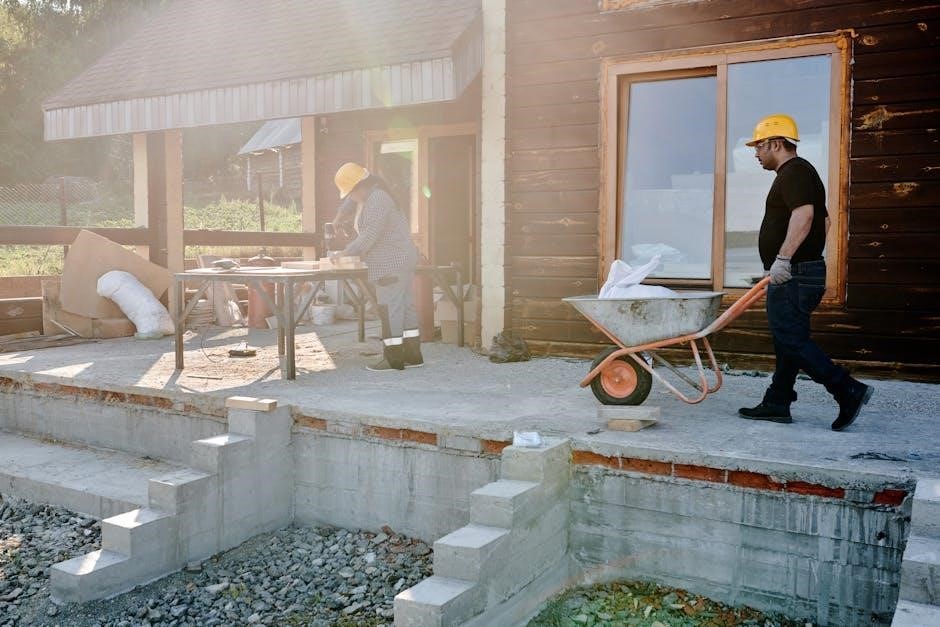A whole house renovation is a transformative process that requires careful planning and execution. This checklist serves as your guide to navigate challenges seamlessly, ensuring a successful outcome for your project.
1.1 Understanding the Importance of a Renovation Checklist
A renovation checklist is essential for organizing and tracking progress, ensuring no detail is overlooked. It helps manage time, reduce costs, and minimize errors. By outlining tasks, timelines, and responsibilities, a checklist provides clarity and accountability. It also allows homeowners to set realistic expectations and prepare for potential challenges. A well-structured checklist ensures that all aspects of the renovation, from planning to execution, are addressed systematically. This tool is vital for maintaining control over the project and achieving the desired outcome. Without a checklist, the risk of delays, budget overruns, and miscommunication increases significantly, making it a cornerstone of successful whole house renovations.
1.2 Benefits of a Comprehensive Renovation Plan
A comprehensive renovation plan offers numerous benefits, ensuring a smooth and efficient process. It helps homeowners and contractors stay aligned, reducing misunderstandings and delays. A detailed plan allows for accurate budgeting, preventing cost overruns and financial stress. By outlining priorities and timelines, it ensures that the project progresses logically, minimizing disruptions. Additionally, a plan fosters better decision-making, enabling homeowners to visualize their goals and make informed choices. It also helps identify potential issues early, allowing for proactive solutions. Overall, a comprehensive plan enhances communication, organization, and control, making the renovation experience less stressful and more rewarding, ultimately leading to a successful outcome.
1.3 Setting Realistic Expectations for Your Project
Setting realistic expectations is crucial for a stress-free renovation experience. Understand that delays, budget overruns, and unforeseen issues are common. Renovations often take longer than anticipated, and costs can exceed initial estimates. Be prepared to adapt your timeline and budget accordingly. Additionally, not all design ideas may be feasible due to structural or financial constraints. Maintaining flexibility and open communication with contractors will help manage expectations. Prioritize your goals and focus on the end result. By aligning your expectations with reality, you can navigate the process more smoothly and enjoy the transformation of your home.
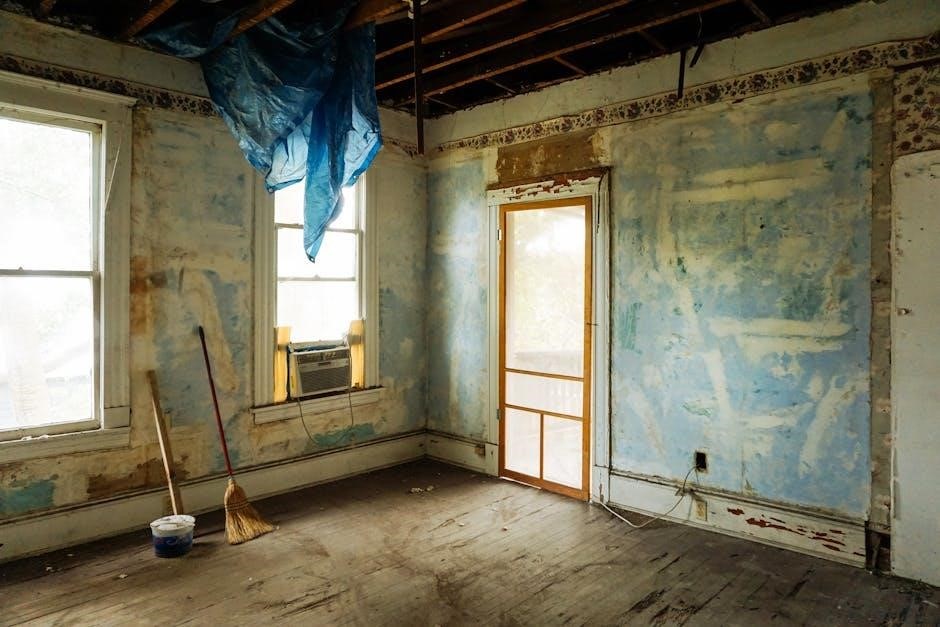
Planning and Preparation
Planning and preparation are essential for a successful renovation. Define the scope, estimate costs, and schedule tasks to ensure a smooth process and achieve your desired outcome.
2.1 Setting a Budget and Timeline
Setting a budget and timeline are crucial steps in planning your renovation. Start by determining how much you can afford, considering materials, labor, and unexpected expenses. Create a detailed timeline, breaking down the project into phases to ensure tasks are completed efficiently. Consider hiring professionals to help estimate costs and durations accurately. A well-defined budget and timeline will help you stay on track, avoid overspending, and manage expectations throughout the renovation process. Regularly review and adjust these plans to accommodate any changes or challenges that arise.
2.2 Defining the Scope of Your Renovation
Defining the scope of your renovation is essential to ensure clarity and focus. Start by listing must-haves and nice-to-haves, prioritizing based on importance and budget. Consider how each space will be used and identify any structural changes needed. Involve architects or designers to translate your vision into actionable plans. A clear scope prevents misunderstandings and scope creep, keeping your project on track. Regularly review and refine your goals to align with your budget and timeline. This step ensures everyone involved understands the project’s objectives, leading to a smoother renovation process and a final result that meets your expectations.
2.3 Hiring Contractors and Professionals
Hiring reliable contractors and professionals is crucial for a successful renovation. Start by asking for referrals from friends or online reviews. Ensure contractors are licensed, insured, and experienced in whole-house renovations. Request multiple bids to compare pricing and services. Verify credentials and check previous work samples. Clearly communicate your project scope and expectations. Ensure contracts include timelines, payment terms, and warranty details. Don’t hesitate to ask questions or seek a second opinion. A professional team will handle complex tasks like structural changes and system upgrades, ensuring your renovation meets safety and quality standards. Avoid contractors who seem unprofessional or unwilling to provide references.

Assessing Your Current Property
Evaluate your home’s structural integrity, electrical, plumbing, and HVAC systems. Identify asbestos or lead needs and document existing conditions to plan renovations effectively and safely.
3.1 Evaluating the Structural Integrity
Evaluating your home’s structural integrity is crucial for a successful renovation. Inspect foundations, walls, floors, and the roof for cracks or water damage. Check for uneven surfaces or sagging areas, which may indicate underlying issues. Assess load-bearing walls and ensure they can support new designs. Look for signs of pest infestation or rot in wooden structures. Consider hiring a structural engineer to identify potential risks and recommend repairs. This step ensures your renovation is safe and durable, preventing costly surprises later. A thorough assessment lays the groundwork for a solid renovation plan.
3.2 Inspecting Electrical, Plumbing, and HVAC Systems
Inspecting electrical, plumbing, and HVAC systems is essential for a smooth renovation. Check electrical systems for outdated components, such as fuse boxes, and ensure circuits can handle modern appliances. Look for signs of wear, like frayed wires or insufficient outlets. For plumbing, inspect pipes for leaks, check water pressure, and verify the condition of water heaters. Evaluate HVAC systems for efficiency, proper sizing, and functionality. Identify any needed upgrades or repairs to avoid future issues. This inspection ensures your home’s infrastructure is safe, functional, and ready for renovations. Addressing these systems early prevents costly surprises and ensures a comfortable living space post-renovation.
3.3 Identifying Asbestos or Lead Removal Needs
Identifying asbestos or lead removal needs is crucial for a safe renovation. Older homes often contain asbestos in insulation, flooring, or ceilings, while lead is commonly found in paint or pipes. Hire certified professionals to inspect these materials, as improper handling can pose serious health risks. Obtain lab-tested samples to confirm the presence of hazardous substances. If found, develop a removal plan that complies with local regulations to ensure safety and avoid legal issues. Addressing these concerns early prevents delays and ensures a healthy living environment. Proper removal is essential before proceeding with any demolition or construction work. Always prioritize safety and compliance when dealing with asbestos or lead.
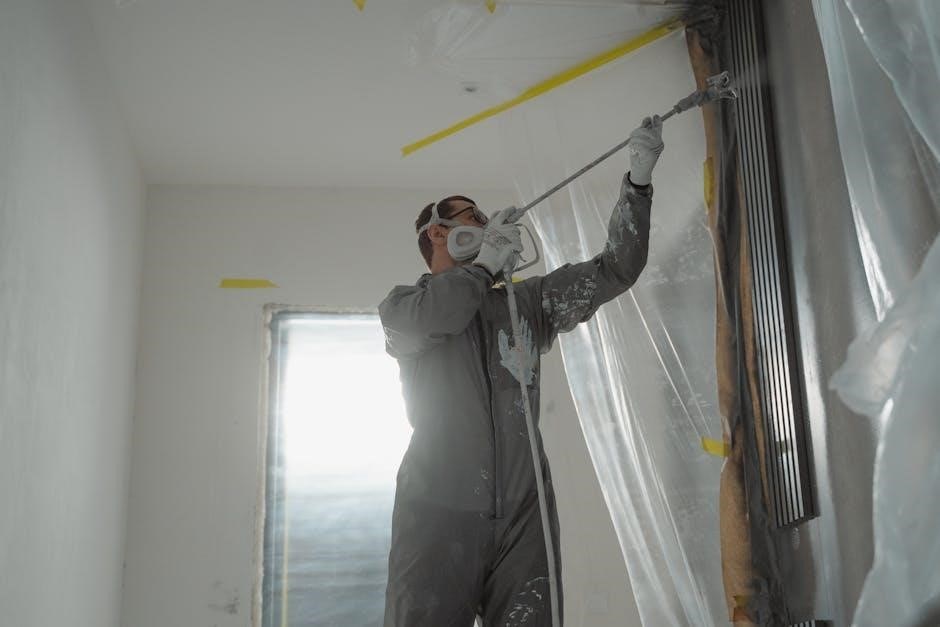
Design and Layout
Design and layout are crucial for a successful renovation, enhancing functionality and aesthetics. Start by developing a concept, then create a detailed floor plan and select materials accordingly.
4.1 Developing a Design Concept
Developing a design concept is the first step in creating a cohesive vision for your renovation. Start by identifying your style preferences, whether modern, traditional, or a blend. Consider the functionality of each space and how it will be used. Gather inspiration from magazines, websites, or social media to visualize your goals. Define the key elements such as color schemes, materials, and lighting to ensure consistency throughout the project. A well-thought-out concept will guide decisions on layouts, finishes, and fixtures, helping to bring your dream home to life seamlessly.
4.2 Creating a Floor Plan and Layout
Creating a detailed floor plan and layout is essential for a successful renovation. Start by measuring your space and noting existing structural elements like doors, windows, and walls. Use design software or sketch by hand to visualize the layout. Consider how each room will be used to ensure functionality and flow. Think about furniture placement, traffic paths, and natural light optimization. A well-designed floor plan enhances livability and aesthetic appeal. It also serves as a blueprint for contractors, ensuring your vision is accurately executed. Prioritize practicality while incorporating your design concept to create a cohesive and functional living space.
4.3 Selecting Materials and Finishes
Selecting materials and finishes is a critical step in your renovation. Consider durability, aesthetics, and functionality when choosing flooring, countertops, cabinets, and fixtures. Research sustainable options like recycled wood or eco-friendly paints to align with your values. Budget plays a key role, so balance high-quality materials with cost-effective alternatives. Create a cohesive look by coordinating colors and textures across rooms. Samples and swatches can help finalize decisions. Ensure materials are compatible with your climate and lifestyle. Proper selection enhances both the beauty and longevity of your home, making it a space that reflects your personal style and meets your practical needs. Planning ahead ensures a seamless design flow.

Preparing for Renovation
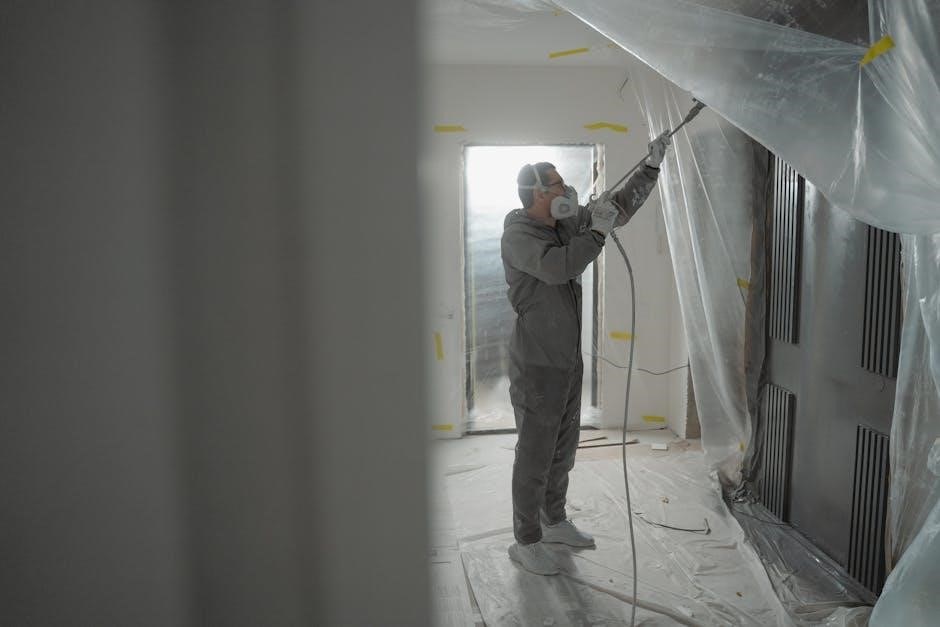
Preparing for renovation involves clearing the site, protecting belongings, and arranging temporary housing. Pack essentials, label boxes, and ensure safety measures are in place for a smooth process.
5.1 Clearing and Cleaning the Site
Clearing and cleaning the site is essential for a smooth renovation process. Start by removing all furniture, fixtures, and personal belongings. Cover floors, walls, and remaining items with protective materials to prevent damage. Clean the space thoroughly, including dusting and vacuuming, to ensure a clean slate for contractors. Label and organize items you plan to reuse or keep. Dispose of or recycle unwanted materials responsibly. Ensure the area is safe and accessible for workers. Finally, document the site before work begins for future reference. A well-prepared site sets the foundation for a successful renovation and minimizes potential disruptions.
5.2 Protecting Belongings and Furniture
Protecting your belongings and furniture is crucial during a whole house renovation. Start by moving fragile or valuable items to a secure, off-site location or a designated storage area. Cover furniture and flooring with durable protective materials like plastic sheets or drop cloths to prevent damage from dust and debris. Label boxes clearly and keep an inventory list to ensure everything is accounted for. Consider renting a temporary storage unit if space is limited. Clean and prepare items before storing them to maintain their condition. This step ensures your possessions remain safe and intact throughout the renovation process, giving you peace of mind.
5.3 Arranging Temporary Housing
Arranging temporary housing is essential during a whole house renovation. Start by evaluating your needs, such as duration, budget, and proximity to work or school. Consider options like renting an apartment, staying with family or friends, or booking a hotel. Consider the cost of utilities, furniture, and deposits if renting. Pack essentials like clothing, toiletries, and kitchenware. Ensure temporary housing is safe and comfortable for all household members. If staying elsewhere, secure storage for your belongings. Plan ahead to avoid last-minute stress and ensure a smooth transition during the renovation period. This step ensures you have a stable place to live while your home is being transformed.
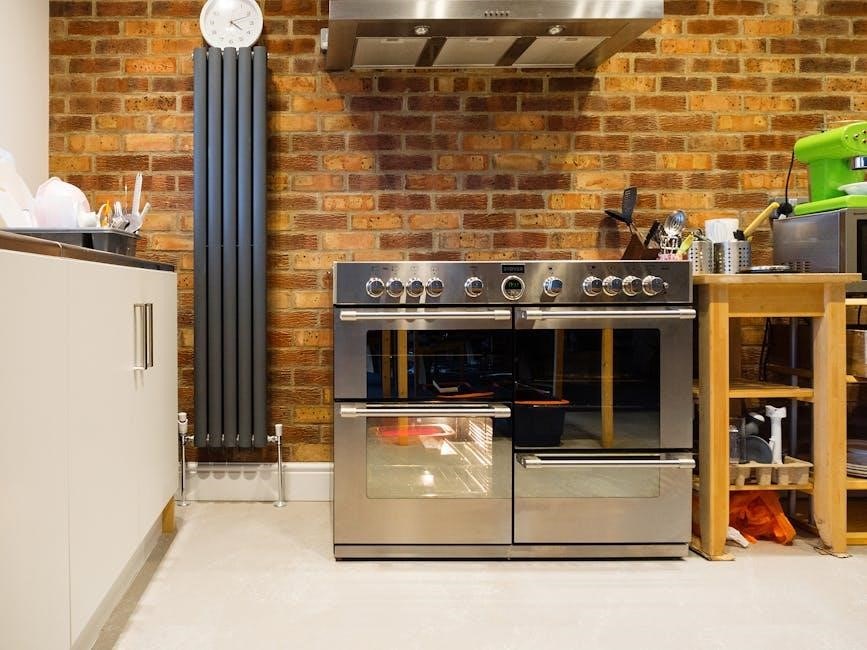
The Renovation Process
The renovation process involves demolition, construction, and installation phases. Proper planning ensures smooth execution, while flexibility addresses unexpected issues, keeping the project on track and stress-free.
6.1 Demolition and Deconstruction
Demolition and deconstruction are the first physical steps in a renovation. These phases involve removing existing structures, materials, and fixtures to prepare the space for new constructions. It’s crucial to hire licensed contractors who follow safety protocols and environmental regulations. Proper planning ensures that the demolition is efficient and minimizes waste. Salvaging reusable materials can reduce costs and support sustainable practices. A detailed checklist helps track progress, ensuring all areas are cleared and prepared for the next phase. Safety gear and permits are essential to avoid legal issues and potential hazards. This step sets the foundation for a smooth renovation process.
6.2 Construction and Installation
Construction and installation mark the rebuilding phase of your renovation. This stage involves framing, installing electrical and plumbing systems, and setting up HVAC. Ensure all materials meet local building codes and that permits are in place. Inspections at each step are critical to avoid costly rework. Communication with contractors is key to staying on track. Proper sequencing of tasks ensures efficiency, while quality control checks maintain standards. This phase lays the foundation for the final aesthetic touches, making it essential to monitor progress closely and address any issues promptly to keep your project on schedule and within budget.
6.3 Handling Unexpected Issues
Unexpected issues are inevitable in whole house renovations. Stay calm and identify solutions promptly to minimize delays. Maintain open communication with contractors to address problems efficiently. A contingency fund is crucial for unforeseen expenses. Regular inspections help catch potential issues early, reducing costly fixes later. Flexibility and quick decision-making are key to keeping the project on track. Document all changes and updates to ensure transparency and accountability. Remember, every challenge is an opportunity to improve the final outcome. Proper problem-solving ensures your renovation stays aligned with your vision and budget, turning potential setbacks into stepping stones for success.
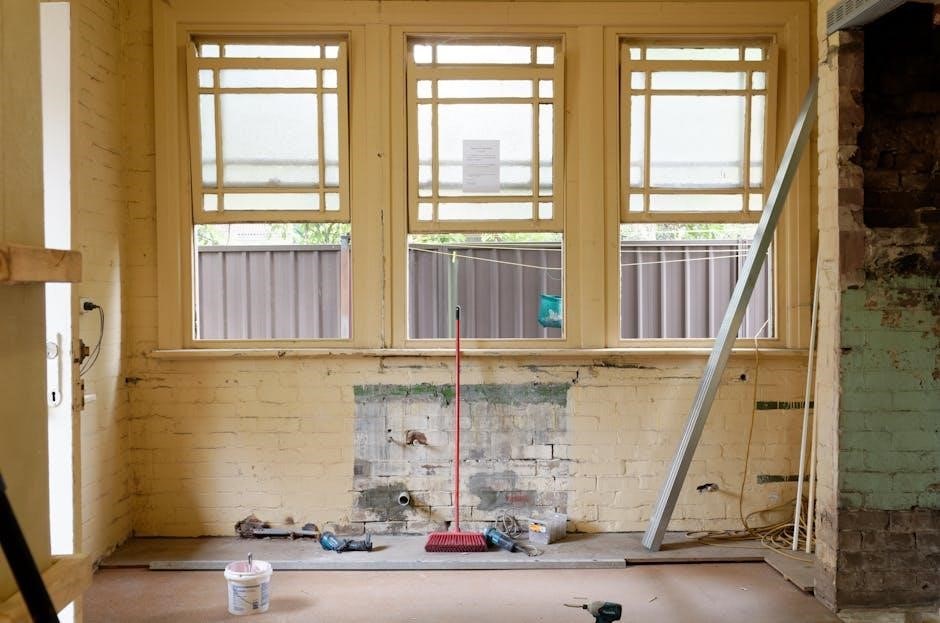
Project Management
Effective project management ensures timely delivery and quality outcomes. Secure materials, maintain quality control, and communicate clearly with contractors to keep your renovation on track and within budget.
7.1 Securing Necessary Materials and Supplies
Securing materials and supplies is crucial for a smooth renovation. Start by budgeting and identifying vendors your contractor recommends to ensure availability. Check lead times for custom or specialty items and consider bulk purchases to avoid delays. Sustainability is key—opt for eco-friendly materials when possible. Verify quantities and specifications with your contractor to prevent shortages or mismatches. Store materials in a dry, secure location to protect them from damage. Finally, document all purchases and deliveries for easy reference and warranty purposes. Proper planning ensures your project stays on track without unnecessary delays or extra costs.
7.2 Maintaining Quality Control
Maintaining quality control ensures your renovation meets high standards and your expectations. Start by conducting regular inspections of completed work and comparing it to your agreed-upon plans. Use a detailed checklist to verify materials, finishes, and installations. Communicate openly with contractors to address any deviations or concerns promptly. Ensure all work complies with local building codes and safety regulations. Document any issues and track their resolution to avoid oversights. Finally, schedule a final inspection before project completion to confirm everything meets your approval. Consistent oversight guarantees a polished and professional result, protecting your investment and ensuring long-term satisfaction.
7.3 Communicating with Contractors
Effective communication with contractors is crucial for a smooth renovation process. Schedule regular meetings to discuss progress, address concerns, and align expectations. Use clear, detailed instructions and ensure all parties understand the project scope. Maintain open lines of communication through phone, email, or collaboration tools. Request daily or weekly updates to stay informed and promptly resolve any issues. Keep a record of discussions, agreements, and changes to avoid misunderstandings. Encourage transparency and ask questions to ensure work meets your standards. Good communication fosters trust and collaboration, helping to deliver a successful renovation that aligns with your vision and goals.
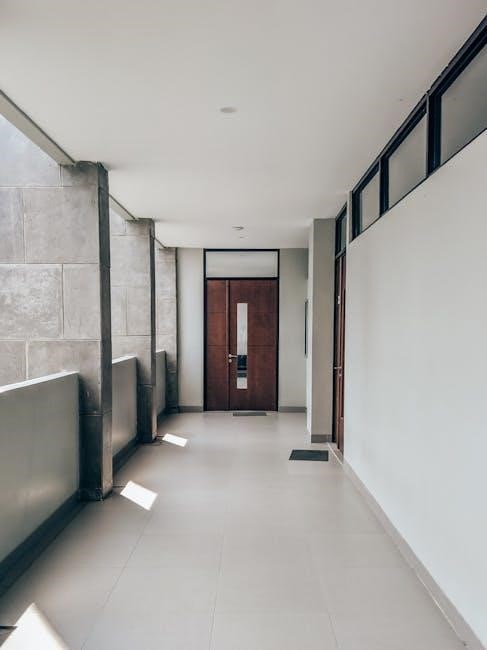
Post-Renovation Steps
After renovation, conduct a final inspection, address any issues, and complete cleaning. Ensure all systems function properly before moving back in and enjoying your newly transformed space.
8.1 Final Inspections and Punch List

Conducting a thorough final inspection is crucial to ensure your renovation meets quality standards. Create a punch list to document any defects or incomplete tasks. Inspect electrical, plumbing, and HVAC systems for proper function. Check all finishes, fixtures, and installations for damage or defects. Ensure compliance with local building codes and regulations. Address any issues with contractors before final payment. A detailed punch list helps ensure all problems are resolved, providing peace of mind and a smooth transition into your newly renovated space.
8.2 Cleaning and Touch-ups
A thorough cleaning is essential before moving back into your renovated home. Focus on deep cleaning all surfaces, including countertops, cabinets, and floors. Pay special attention to kitchens and bathrooms, where grout, tile, and appliances may require extra attention. Address any minor scratches or scuffs on walls, floors, or ceilings with touch-up paint or repairs. Ensure windows are spotless and all lighting fixtures are free of dust. Finally, arrange for a professional cleaning service if needed to ensure your space is move-in ready. This step ensures your renovation’s final result is pristine and reflects your investment in transforming your home.
8.3 Moving Back In
Moving back into your newly renovated home is an exciting milestone. Start by carefully unpacking and organizing your belongings, ensuring everything has its designated space. Check that all systems, fixtures, and appliances are functioning properly before settling in. Take time to familiarize yourself with any new features or smart home technologies installed during the renovation. Consider personalizing your space with decorative touches to make it truly yours. Finally, host a small gathering or walk-through to celebrate the successful completion of your project and enjoy the fruits of your planning and effort in creating your dream home.
